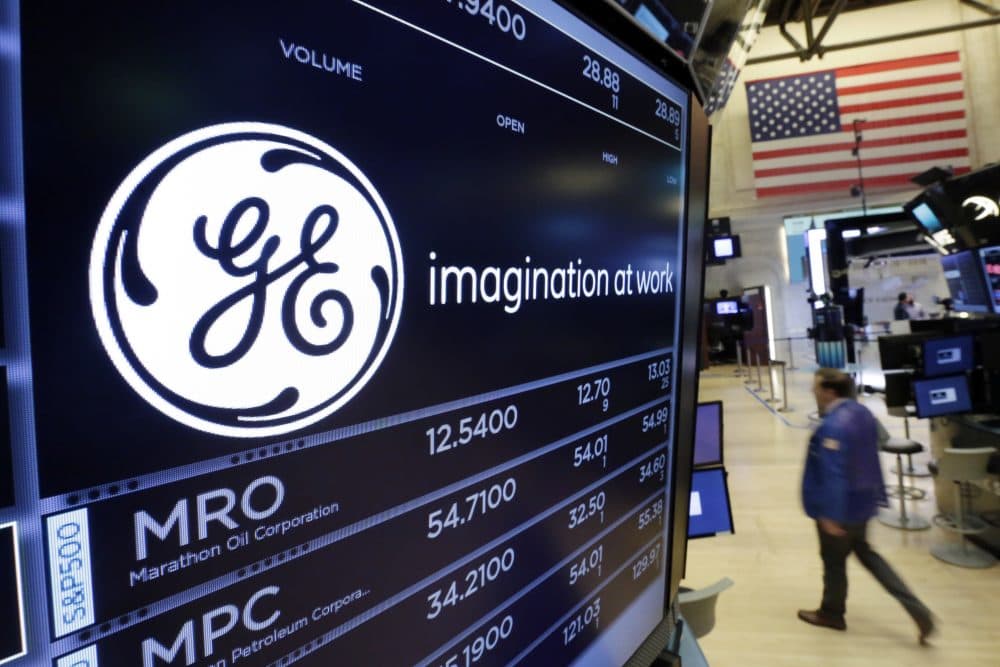Advertisement
After Big Quarterly Earnings Drop, GE Set To Reveal Cost-Cutting Restructuring Plan

General Electric is set to announce plans that will transform the company.
In a pre-market opening call to institutional investors on Monday, GE CEO John Flannery will detail his vision for restructuring the company, in an attempt to stop the free fall in the company's stock price.
The price of GE's shares has plummeted nearly 40 percent, shedding more than $80 billion in market value. Its third quarter earnings this year saw the biggest drop in 17 years.
When Flannery replaced the company's longtime CEO Jeffrey Immelt in August, he ordered a deep dive into all aspects of the company’s business divisions, which operate in over 170 countries and employ 295,000 workers.
“We need to make some major changes with urgency and depth of purpose,” Flannery said last month when he announced GE’s dismal third-quarter results. “Everything is on the table.”
In March, Flannery said GE would cut $2 billion in operating expenses over the next two years, twice as much as previously announced. During its third quarter earnings call in October, Flannery increased that goal to $3 billion over the next two years. The company is also delaying construction of its new corporate headquarters in Boston and selling off $20 billion of businesses.
Reuters reported Friday that GE is laying off sales staff and other employees in its software division. Also on the chopping block could be the transportation division, oil and gas and aviation leasing.
“There are no sacred cows,” Flannery said.
Gita Rao, a senior lecturer in finance at MIT’s Sloan School of Management, said she was encouraged by Flannery’s statement.
Rifling through a stack of printouts measuring the company's recent performance, Rao did not have to go far through the pile to find what she says is GE’s problem.
“It’s really, really under-performed," she said. "The core businesses it’s in are slow-growing.”
Revenues from the company’s oil and gas unit declined 5 percent year over year, and operating profit fell 35 percent.
“It’s clear the company isn’t generating enough cash flow to cover the dividend,” Rao said. “The question isn’t, 'Will the dividend be cut,' but by how much."
GE is known as a “widows and orphan stock” because it has reliably paid dividends since 1899. The current dividend is 4 percent, or 96 cents a share.
Flannery acknowledged that the company's cash flow has dried up. He now has the job of convincing investors not to dump GE stock if he trims or cuts the dividend. Some analysts speculate he will reduce the payout by a quarter or by half — or even eliminate it entirely until the company is reorganized.
One near certainty: GE will not be borrowing money to maintain its dividend.
Immelt had tried to return the company to its industrial roots by selling off most of the its financial services, its appliance division and its media businesses. He envisioned a new "digital industrial" company formulated around its Predix cloud-based software, which is designed to monitor industrial equipment to maximize performance and efficiency.
But now investors have to be convinced not to lose patience with GE or companies like it. The Germany-based industrial conglomerate Siemens is suffering from many of the same problems as GE.
"We have understood that conglomerates of the old-fashioned kind have no future," Siemens CEO Joe Kaeser said in early November.
Rao said she agrees with that statement.
"The days of the integrated transnational corporation may be coming to an end,” she said, adding that U.S.-based companies focused on one industrial sector are doing much better than Siemens or GE.
Flannery acknowledges that GE's problems go beyond financials and strategies.
“I'm focusing heavily on the culture of the company,” he said. "Our culture needs to be driven by mutual candor and intense execution and accountability.”
Wall Street institutional investors will be paying attention to Flannery's every word when he reveals his plan Monday morning.
Correction: An earlier version of this post misstated the latest figures of GE's cost-saving measures. We regret the error.
This article was originally published on November 11, 2017.
